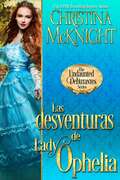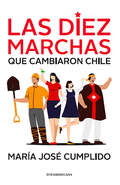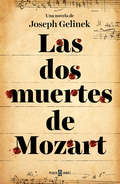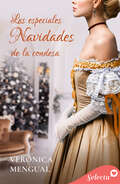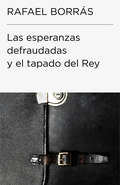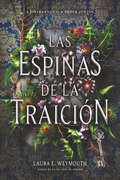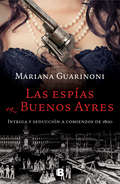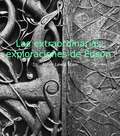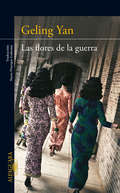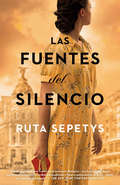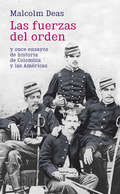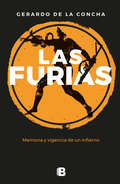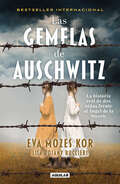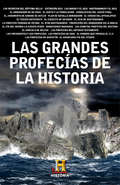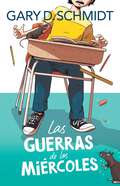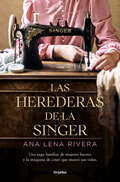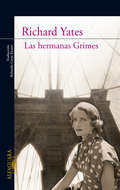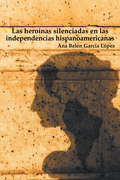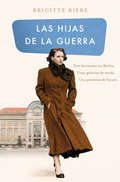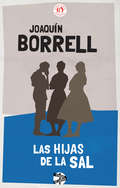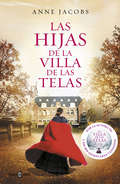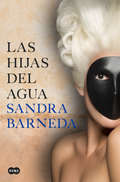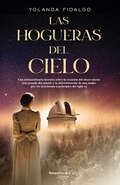- Table View
- List View
Las desventuras de Lady Ophelia
by Christina McKnightTranquila, reservada, Lady Ophelia Fletcher siempre tiene su nariz metida en un libro; por lo tanto ella no fue testigo de la muerte de su amiga aquella trágica noche. Ahora, escribe en la columna del Confidencial de Mayfair para exponer a los hombres insípidos, una forma de enmendar por no respaldar los reclamos de asesinato de su amiga. Cuando un extraño buen mozo llega a reunirse con su padre, Ophelia se esperanza con investigar al elegante lord. Colin Parnell, Lord Hawke, tiene una promesa que cumplir: encontrar el libro que prueba que su abuelo trabajó como espía para el Rey George II y no murió como un contrabandista de la costa de Kent bueno para nada. Envuelto en el misterio y el escándalo, la familia Parnell estuvo en guerra uno con otros por décadas, y Colin está determinado a detener esto descubriendo la prueba del pasado honorable de la familia. Desafortunadamente, el libro que él busca está en poder de una belleza de cabellos color fuego, y necesitará utilizar la ayuda de Ophelia para descubrir la verdad. Ophelia está más que feliz de usar sus habilidades para ayudar a Lord Hawke. Pero por su búsqueda de respuestas ¿serán llevados hacia la desventura, o conseguirán algo mas grande por lo que negociar: la verdad y el uno para el otro?
Las diez marchas que cambiaron Chile
by Maria José CumplidoCrónica histórica sobre los 10 movimientos ciudadanos que cambiaron el rumbo de la historia de Chile. A través de la historia, los movimientos obrero, feminista y antidictadura han salido a la calle a protestar por los derechos ciudadanos que buscan reivindicar. La historia muestra que lo que hoy vivimos tiene antecedentes que refuerzan que la movilización callejera, frontal, incluso violenta, es la forma que se ha usado en Chile para conseguir cambios sociales reales. El relato de la autora de Chilenas, historiadora de profesión, incluye los siguientes hitos: 1. Michimalonko quema Santiago 1541 2. Huelga de la carne 1905 3. Huelga Grande de Tarapacá (primera huelga nacional y Matanza de Santa María) – 1907 4. Proceso de los Subversivos (protestas lideradas por la Fech) 1920 5. La huelga de arrendatarios 1925 6. La revolución de la chaucha 1949 7. Primera protesta de la comunidad LGBTQ 22 de abril 1973 8. Jornadas de Protesta de Mujeres contra la dictadura 1986 9. Triunfo del NO 1988 10. Marchas estudiantiles 2011
Las dos muertes de Mozart
by Joseph GelinekJoseph Gelinek regresa con su thriller histórico más ambicioso hasta el momento en torno a una de las figuras más importantes e influyentes de la historia de la música: Wolfgang Amadeus Mozart. Italia, en la actualidad. Un cadáver en descomposición aparece en un hotel de la Toscana. El forense dictamina que ha sido envenenado con una pócima llamada acqua toffana, un poderoso veneno destilado en el siglo XVIII. Ajena a estos hechos, Teresa Salieri, la única descendiente viva del compositor Antonio Salieri, lucha por limpiar el nombre de su antepasado con la ayuda de Laura, su joven ayudante. Según la tradición popular, Salieri envenenó a Mozart consumido por la envidia. Viena, siglo XVIII. Salieri entra a formar parte del grupo musical del emperador con solo dieciséis años mientras Leopold Mozart, padre del célebre compositor, llega a la ciudad con sushijos para exhibirlos en la corte. Los encontronazos entre Leopold y todo aquel que hace sombra a su hijo, empezando por Salieri, empiezan a recrudecerse hasta que Mozart cae enfermo. Todo apunta a que ha sido envenenado con acqua toffana, pero ¿quién quiere acabar con la vida del joven genio? ¿Fue realmente Salieri el segundón musical, envidioso y perverso, que acabó envenenando a su rival más directo? ¿Qué papel jugó Leopoldo, el padre de Mozart, en la rivalidad de los dos genios musicales? La verdad sobre la muerte de Mozart lleva oculta demasiado tiempo y hay quien está dispuesto a todo con tal de revelarla.
Las especiales navidades de la condesa
by Verónica MengualElla es una dama refinada, él un americano arrogante... Saltarán chispas. La condesa viuda de Arleen no está preparada para que su hija contraiga matrimonio. Tampoco lo está para el hombre que su pequeña ha elegido y, definitivamente, nada en este mundo la hubiese preparado para conocer al padre de su futuro hijo político...
Las esperanzas defraudadas y el tapado del Rey (Colección Endebate #Volumen)
by Rafael BorrásEl retrato heterodoxo de tres personajes clave del tardofranquismo y la transición: Suárez, Fraga y Areilza. En la historia política española, la figura de los ministros, «los interinos» en expresión afortunada, ha dejado muchos personajes para el recuerdo. El veterano editor Rafael Borrás, que ha publicado biografías y memorias de un porcentaje muy elevado de ellos, elige tres figuras clave del tardofranquismo y la transición, dos cuyas ambiciones se frustraron, Areilza y Fraga, y uno cuyo papel protagonista fue una sorpresa para todos, Adolfo Suárez, para elaborar un extraordinario y personalísimo retrato de la época.
Las espinas de la traición: A Treason of Thorns (Spanish edition)
by Laura E WeymouthObscura, cautivante y completamente única, esta evocadora fantasía histórica escrita por la autora aclamada por la crítica Laura E. Weymouth es perfecta para los fans de The Hazel Wood y Caraval.Violet Sterling ha pasado los últimos siete años en el exilio deseando regresar a la Casa Burleigh. Siendo una de las seis Casas Grandes de Inglaterra, la magia de Burleigh ha mantenido muy felices tanto a la campiña como a Violet.Esto fue así hasta que la traición de su padre haya destruido todo.Ahora se le ha dado la oportunidad de regresar a su hogar, pero Burleigh no es el mismo lugar que ella recordaba. Atormentada de dolor, el alma de la Casa Burleigh llora en pena. Mientras su magia apesadumbrada hace estragos en la campiña, Vi tiene que decidir hasta donde está dispuesta a llegar para salvar su casa… antes que esta destruya todo lo que ella ha conocido hasta ahora.Una casa sin control puede llevarte a la ruina,pero no dejaré que me arruine a mí.
Las espías en Buenos Ayres: Intriga y seducción a comienzos de 1800
by Mariana GuarinoniMujeres espías, intrigas políticas, pasiones y amores prohibidos sobre el final del Virreinato del Río de la Plata. Un fresco excepcional de una época difícil que muestra claramente las estrategias de supervivencia de las mujeres de la época, así sean ricas o indigentes. Marie Anne Périchon de Vandeuil, amante del virrey Liniers y abuela de Camila O'Gorman, fue una mujer poderosa y controvertida. La más bella del Río de la Plata, la más astuta, la más odiada. Se la acusó de ser espía inglesa, espía francesa y espía de los criollos independentistas. ¿Quién fue en realidad Anita, La Perichona? Nacida en una isla africana, Annette cargaba con la nacionalidad francesa y un marido irlandés, un bagaje incómodo para mudarse a un virreinato español. Tuvo que utilizar intrigas y juegos de seducción para sobrevivir hasta que una poderosa pasión la llevó a perder el control de su vida. Sus enemigos se aprovecharon de esa debilidad para mandarla al exilio. Su única aliada resultó Mary Clarke, una ladrona inglesa fugitiva devenida en prostituta de lujo que era amante de su marido. Una relación de rivalidad y complicidad entre las dos mujeres más poderosas y polémicas de los últimos días del Virreinato del Río de la Plata.
Las extraordinarias exploraciones de Edson: Una novela corta escrita por Asher Lewis Stam
by Asher Lewis StamUna novela que lleva al lector por un vieje a través del temprano periodo medieval. Descrubre con Edson, el joven protagonista, el mundo más allá de la comodidad de su pueblo y las relalidades de la naturaleza humana. Sé testigo de las ideologías sobre la ley y el orden llevadas a cabo por personas de tierras lejanas. ¿Habrás similitudes con algunos países hoy en día?
Las flores de la guerra
by Geling YanUna sobrecogedora historia de miedo y violencia, pero también de amor, pasiones ingobernables, amistad y compasión, que Zhang Yimou llevó al cine en la mayor producción cinematográfica de la historia de China. 1937, Nanjing: el ejército japonés ha entrado en la capital china a sangre y fuego. La guerra ha atrapado a Shujuan junto con otras doce estudiantes en el desván de la parroquia Santa María Magdalena, al cuidado del padre Engelmann. Aunque hay algo que sacude su mundo con más fuerza que el sonido de los disparos. Cuando la misteriosa y seductora Zhao Yumo llega al frente de un grupo de prostitutas en busca de refugio, las niñas y los clérigos tienen que enfrentarse a sus propias encrucijadas: ¿dónde está la justicia?, ¿qué los distingue de esas mujeres?, ¿cómo defenderse de la crueldad? Reseñas:«Una vez más Yan da la talla y nos regala una espléndida narración con un puñado de personajesinolvidables que siguen acompañando al lector cuando ya ha cerrado el libro.»Jesús Ferrero, Babelia «Yan conmueve al lector en lo más profundo de su ser. Mucho después de haber concluido la lectura, las imágenes perduran y regresan las preguntas, preguntas necesarias en tiempos extremos.»Amy Tan
Las fuentes del silencio
by Ruta SepetysLa autora de Lágrimas en el mar y Entre tonos de gris regresa con un extraordinario y cautivante relato de amor, silencio y secretos situado en la época de la dictadura de Franco en España. Madrid, 1957. Bajo la dictadura fascista del General Francisco Franco, España esconde un oscuro secreto. Entre los empresarios y turistas extranjeros que llegan al país con la acogedora promesa del sol y del buen vino se encuentra Daniel Matheson, hijo de un magnate petrolero de Texas que llega a Madrid con sus padres a los dieciocho años con la esperanza de conocer la patria de su madre a través del lente de su cámara fotográfica. La fotografía—y el destino—lo llevan a conocer a Ana, cuya familia enfrenta obstáculos que revelan las consecuencias de la reciente Guerra Civil Española y las escalofriantes repercusiones de la fortuna y el miedo. Las fotografías de Daniel lo dejan con preguntas incómodas entre acechantes peligros y se ve acorralado, teniendo que tomar decisiones difíciles para proteger a los que ama. Las vidas y los sentimientos acaban enfrentándose, revelando el lado más oscuro de la soleada ciudad de Madrid. La gran narradora Ruta Sepetys vuelve a arrojar luz en uno de los rincones más oscuros de la historia reciente en esta épica y desgarradora novela sobre la identidad, el amor inolvidable, las repercusiones de la guerra y la violencia oculta tras el silencio, inspirada por los conflictos reales de la España en postguerra.
Las fuentes del silencio
by Ruta SepetysLa autora de Lágrimas en el mar y Entre tonos de gris regresa con un extraordinario y cautivante relato de amor, silencio y secretos situado en la época de la dictadura de Franco en España. Madrid, 1957. Bajo la dictadura fascista del General Francisco Franco, España esconde un oscuro secreto. Entre los empresarios y turistas extranjeros que llegan al país con la acogedora promesa del sol y del buen vino se encuentra Daniel Matheson, hijo de un magnate petrolero de Texas que llega a Madrid con sus padres a los dieciocho años con la esperanza de conocer la patria de su madre a través del lente de su cámara fotográfica. La fotografíay el destinolo llevan a conocer a Ana, cuya familia enfrenta obstáculos que revelan las consecuencias de la reciente Guerra Civil Española y las escalofriantes repercusiones de la fortuna y el miedo. Las fotografías de Daniel lo dejan con preguntas incómodas entre acechantes peligros y se ve acorralado, teniendo que tomar decisiones difíciles para proteger a los que ama. Las vidas y los sentimientos acaban enfrentándose, revelando el lado más oscuro de la soleada ciudad de Madrid. La gran narradora Ruta Sepetys vuelve a arrojar luz en uno de los rincones más oscuros de la historia reciente en esta épica y desgarradora novela sobre la identidad, el amor inolvidable, las repercusiones de la guerra y la violencia oculta tras el silencio, inspirada por los conflictos reales de la España en postguerra.
Las fuerzas del orden
by Malcolm DeasEn estos doce ensayos escritos en las últimas dos décadas, Malcom Deas habla sobre historia militar y económica en Colombia historia política venezolana y fronteras y choques culturales en las Américas. Con gran sentido de los contextos y un uso perspicaz de las fuentes este texto ilumina personajes, hechos y fuerzas, que en su mayoría comprenden episodios de finales de la Colonia y de las posteriores jóvenes repúblicas. La prosa de Malcolm Deas se nutre de sutil ironía y humor lúcido, y sus ensayos, por polémicos que resulten, tienen la ventaja de ser entretenidos. Armas, letras, economistas y tempranas economías, historia electoral, Francisco Miranda -el pensador y el militar-, fronteras culturales en América, y hasta el traslado de los huesos de Jorge Isaacs, se conjugan en un libro abierto a los descubrimientos. Su diversidad y amplitud componen un panorama que anima a la historia comparada, y que individualmente, y en suma, son una defensa del ensayo como género.
Las furias: Memoria y vigencia de un infierno.
by Gerardo de la Concha"En este mundo todavía hay muchas aventuras, ¿no crees? Vamos a vengarnos. ¿Qué importan entonces Dios o el Diablo, si vamos a ser dueños de la muerte, como sólo ellos lo son, existan o no?" Es el México de los años setenta y Germán, un adolescente aficionado a la lectura de los clásicos, es reclutado por la guerrilla revolucionaria. A partir de ese momento, toda su vida se transforma y toma el rumbo de la noche encubierta, de la sangre derramada, de la disidencia política. Más adelante los tiempos cambian y los sueños revolucionarios se desvanecen entre los vientos de la modernidad. Germán lo sabe y se convierte en un agente de alto nivel del poder en curso. Pero los errores y crímenes del pasado no dejan en paz a este antiguo militante, quien se convierte en el ejecutor implacable de una oscura venganza que se debate entre la expiación y la culpa. Tres mujeres, igualmente trágicas y bellas, lo acompañan; se trata de las tres Gracias (verdad, belleza e inocencia) que alumbrarán su sangriento camino. ¿Logrará Germán saldar las cuentas con su pasado y salir indemne?
Las gemelas de Auschwitz
by Eva Mozes KorLa historia real de dos niñas frente al Ángel de la Muerte Eva Mozes Kor tenía sólo diez años cuando llegó a Auschwitz. Sus padres y dos hermanas mayores fueron llevados a las cámaras de gas, pero ella y su gemela Miriam fueron puestas al cuidado del hombre conocido como el Ángel de la Muerte, el sanguinario doctor Josef Mengele, quien realizaba crueles experimentos sobre todos los gemelos que encontraba, en su delirante afán por entender la genética y mantener pura a la raza aria. En estas páginas, Kor relata cómo luchó a diario por su supervivencia y la de su hermana en condiciones infrahumanas frente a una maldad difícil de comprender.
Las grandes profecías de la historia
by Canal HistoriaSegún los mayas y otras culturas milenarias, el fin del mundo está muy cerca... Canal de Historia desvela, de forma amena y rigurosa, las profecías más famosas de la historia. Profecías religiosas, bíblicas, profanas, de iluminados anónimos o de ilustres personajes, Las grandes profecías de la Historia recoge en veinticinco capítulos los principales y más famosos vaticinios de la historia de la humanidad. De los griegos a los egipcios, pasando por los cristianos y los mayas, todas las grandes civilizaciones se han preocupado por controlar su destino prediciendo el futuro y, en muchas ocasiones, han acertado. Canal de Historia acompaña al lector en un revelador recorrido por uno de los más oscuros e inexplorados caminos de la historia, para desvelar quién predijo los atentados del 11-S, cómo marcaban el destino de los mortales las pitonisas de Delfos o en qué momento llegará el Juicio Final para los cristianos. Leonardoda Vinci, Nostradamus, Newton, Rasputín o Edgar Cayce son algunos de los nombres propios que, junto con expertos anónimos de diferentes culturas y credos, han realizado sus propias predicciones a lo largo de los siglos. ¿Cuánto hay de invención y cuánto de realidad en cada una de ellas?, ¿cuáles tienen base científica?, ¿en qué casos se han cumplido? Con su habitual mezcla de entretenimiento y rigor, Canal de Historia responde a estas y otras preguntas en un libro que apasionará por igual a aficionados e inexpertos de la parte más esotérica de la historia.
Las guerras de los miércoles / The Wednesday Wars
by Joanna WeaverNovela ganadora del Newbery Honor Holling Hoodhood está en problemas. Acaba de comenzar el séptimo grado con la señora Baker, y presiente que la maestra tiene algo en su contra. ¿Por qué otra razón lo haría leer a Shakespeare fuera del horario de clases? Es el año 1967, y todo el mundo tiene cosas más importantes de qué preocuparse. Por un lado, está Vietnam, y por otro está el negocio familiar. Según el padre de Holling, nada es más importante que el negocio familiar. De hecho, todos los Hoodhood tienen que comportarse siempre lo mejor posible: el éxito de Hoodhood y Asociados depende de ello. ¿Pero cómo puede Holling evitar los problemas si tiene que lidiar con la señora Baker?
Las herederas de la Singer
by Ana Lena RiveraLas herederas de la Singer cuenta la conmovedora historia de las mujeres de una familia ligadas a una máquina de coser que custodió un secreto durante cuatro generaciones. El día que la joven Aurora se vio obligada a trabajar en la mina tras el accidente de su padre, se juró a sí misma hacer lo que fuera necesario para salir de aquel infierno. Un matrimonio sin amor y la máquina de coser Singer de segunda mano que recibe como regalo de bodas le proporcionarán una nueva forma de salir adelante, hasta que un terrible suceso convierte la Singer en la única prueba de la amenaza que la perseguirá toda la vida. Muchos años después, la complicidad que teje con su biznieta Alba desvelará el secreto que ha planeado sobre las mujeres de su familia. Reseña:«Ana Lena Rivera exhibe un lenguaje fresco y contemporáneo, además de una gran habilidad a la hora de construir espacios cotidianos.»Jurado XXIX Premio Torrente Ballester
Las hermanas Grimes
by Richard YatesLa Nueva York de los años treinta a los setenta, a la que llegan los ecos de la Segunda Guerra Mundial y del psicoanálisis, es el escenario de esta novela valiente y demoledora, profundamente humana. «Ninguna de las hermanas Grimes estaba destinada a ser feliz, y al echar una mirada retrospectiva siempre da la impresión de que los problemas comenzaron con el divorcio de sus padres.» Así empieza esta magistral novela del autor de Vía Revolucionaria: la historia de dos hermanas que construyen sus vidas por caminos opuestos. Para Sarah, el matrimonio y la vida familiar son un refugio seguro, aunque no garanticen la felicidad. Emily, en cambio, busca en un hombre tras otro las respuestas que no puede darse a sí misma, y procura en vano huir de la soledad. Reseñas:«Lo que aquí podemos encontrar, sumado a la bella escritura, es aquello que hace que un libro resulte de manera inmediata intensa y brillantemente vivo. Si se necesita algo más para realizar una obra maestra, no sé de qué se trata.»Tennessee Williams «Pocos hombres, desde Flaubert, han mostrado tanta compasión por aquellas mujeres cuyas vidas son un infierno.»Kurt Vonnegut «Yates es, junto a Scott Fitzgerald y Hemingway, uno de los tres indiscutibles grandes novelistas norteamericanos del siglo XX.»David Hare «Una novela elocuente y conmovedora, sutilmente aguda.»The Washington Post «Su estilo llano, discreto, tiñe las vidas de las hermanas Grimes de una tremenda fuerza mientras, escena a escena, la desencantada Emily va dejando atrás sus sueños. El efecto es dulce y cruel al mismo tiempo, doloroso y brutal... Las hermanas Grimes tiene una asombrosa ligereza y densidad.»The Boston Review «Extraordinariamente bueno... Escrito con la intensidad y la sencillez de las verdades absolutas.»The San Francisco Sunday Examiner & Chronicle «Yates escribe de manera contundente y nos sumerge sin esfuerzo en la vida de sus personajes... Un contenido pero conmovedor relato.»The New York Times Book Review «Ya conocemos a John Updike y a Philip Roth, pero el gran novelista americano olvidado del siglo XX es Richard Yates... Ahora que su obra resurge gracias a Revolutionary Road, la película protagonizada por Leonardo DiCaprio y Kate Winslet, este gran visionario se unirá a los gigantes de la narrativa americana.»The Guardian
Las heroínas silenciadas en las independencias hispanoamericanas
by Ana Belén García LópezEl libro que hace visible lo que la historia silenció: la participación de las mujeres en las independencias hispanoamericanas <P><P>Las heroínas silenciadas en las independencias hispanoamericanas revela la participación de las mujeres en los procesos independentistas hispanoamericanos denunciando el silencio histórico al que fueron condenadas, rescatándolas de la ingratitud con que fueron tratadas y reivindicando el mérito, la dignidad y el protagonismo de aquellas mujeres cuya labor fue decisiva en el triunfo de la independencia.
Las hijas de la guerra: Tres hermanas en Berlín. Unas galerías de moda. Una promesa de futuro. (Las hermanas de Kudamm #Volumen 1)
by Brigitte RiebeTres hermanas en Berlín. Unas galerías de moda. Una promesa de futuro. Berlín, mayo de 1945: es la hora cero, la ciudad está en ruinas, así como las almas de sus gentes. Los grandes almacenes Thalheim am Ku'damm también han quedado completamente destruidos. Rike, Silvie y Florentine, las tres hermanas herederas del negocio, contemplan aterradas y petrificadas las ruinas del orgullo familiar. Pero Rike no está dispuesta a que su vida transcurra entre los escombros. Ella tiene un proyecto y está dispuesta a dejarse la piel para llevarlo adelante: reconstruir los grandes almacenes y darle color al triste Berlín de la posguerra con telas refinadas, colores pastel y las últimas creaciones de moda. Después de la reforma monetaria, la gente empieza a tener ganas de consumir, de participar de lo que parece un nuevo milagro económico, de olvidar la guerra y la miseria. Sin embargo, los nuevos tiempos arrastran problemas del pasado y cuando un oscuro secreto parece arrojar una luz nada gloriosa sobre las galerías de moda y su historia, las tres hermanas se darán cuenta de que el pasado sigue muy vivo.
Las hijas de la sal
by Joaquín BorrellVíctor Val-Gilbert, heredero de una familia de terratenientes en el pueblo valenciano de Benimarells, fue dado por desaparecido en el desastre de Annual. Allí mató al hijo de un jeque, que lo ha retenido como prisionero durante veinte años en el desierto. Cuando regrese en 1943 con la voluntad de reincorporarse a la vida del pueblo en plenas secuelas de la Guerra Civil Española, cuyos antecedentes y circunstancias ignora totalmente, encontrará, para empezar, que las tres hijas de Soledad, su amor de juventud, tienen la edad de la madre cuando él partió. Sabrá también que su padre, coronel del ejército, fue asesinado por un oficial italiano sin que nunca se investigase el asunto a fondo. Andará por la zona el maquis tratando de resistir en una lucha imposible contra la dictadura, y deberá convivir con una criada de raza negra, protegida de su padre, cuyo misterioso pasado nadie conoce de verdad. El tiempo, detenido para Víctor durante dos décadas, ha cambiado irreversiblemente el mundo que él dejó. Pero no por eso dejará de precipitarse, a su regreso y a su pesar, el ajuste de cuentas que jamás fue saldado.
Las hijas de la villa de las telas
by Anne JacobsDespués de La villa de las telas llega la segunda parte de esta saga romántica histórica para fans de Downton Abbey, María Dueñas, Kate Morton o Lucinda Riley, que ha cautivado a más de un millón y medio de lectoras. Una poderosa familia.Una guerra terrible.Una mansión que esconde más de un secreto... El destino de una familia en tiempos convulsos y un amor que todo lo vence. Augsburgo, 1916. La mansión de la familia Melzer pasa a ser, por necesidad, un hospital militar. Las hijas de la casa, ayudadas por el servicio, se convierten en enfermeras que curan, cuidan y escuchan a los heridos en combate. Entretanto, Marie, la joven esposa de Paul Melzer, se hace cargo de la fábrica de telas en ausencia de su marido. Sin embargo, recibe una terrible noticia: su cuñado ha caído en el frente y Paul es ahora un prisionero de guerra. Marie se niega a que las circunstancias la venzan y lucha con todas sus fuerzas por preservar el patrimonio familiar. Pero, mientras no pierde la esperanza de volver a ver a Paul con vida y se deja la piel en la fábrica, el elegante Ernst von Klippstein aparece en la puerta de la mansión, empeñado en no perder de vista a la joven y bella mujer que tiene entre sus capaces manos el destino de la familia Melzer. Esta apasionante saga familiar terminará en la tercera parte El legado de la villa de las telas. La crítica ha dicho...«Es una gran historia de amor, con tintes dramáticos y secretos familiares, que nos ha gustado tanto por su calidad literaria como por su preciosismo histórico.»Revista Kritica «Una novela histórica muy entretenida que capta el ambiente decomienzos del siglo XX.»Fränkische Nachrichten «Downtown Abbey en Augsburgo.»Histo-couch «Este libro lo tiene todo, todo que podríamos desear para un día de lluvia: una gran historia de amor, intriga [...] y un gran secreto familiar.»Delmenhorster Kreisblatt «Con su escritura fluida, Anne Jacobs sabe cómo seducir a sus lectoras y transportarlas a la vida de la alta sociedad de hace cien años con todo su glamour pero también con sus sombras.»Weilheimer Tagblatt
Las hijas de la villa de las telas (Inspector Mascarell Ser. #3)
by Anne JacobsDespués de La villa de las telas llega la segunda parte de esta saga romántica histórica para fans de Downton Abbey, María Dueñas, Kate Morton o Lucinda Riley, que ha cautivado a más de dos millones de lectoras. Una poderosa familia.Una guerra terrible.Una mansión que esconde más de un secreto... El destino de una familia en tiempos convulsos y un amor que todo lo vence. Augsburgo, 1916. La mansión de la familia Melzer pasa a ser, por necesidad, un hospital militar. Las hijas de la casa, ayudadas por el servicio, se convierten en enfermeras que curan, cuidan y escuchan a los heridos en combate. Entretanto, Marie, la joven esposa de Paul Melzer, se hace cargo de la fábrica de telas en ausencia de su marido. Sin embargo, recibe una terrible noticia: su cuñado ha caído en el frente y Paul es ahora un prisionero de guerra. Marie se niega a que las circunstancias la venzan y lucha con todas sus fuerzas por preservar el patrimonio familiar. Pero, mientras no pierde la esperanza de volver a ver a Paul con vida y se deja la piel en la fábrica, el elegante Ernst von Klippstein aparece en la puerta de la mansión, empeñado en no perder de vista a la joven y bella mujer que tiene entre sus capaces manos el destino de la familia Melzer. Esta apasionante saga familiar continúa en la tercera parte El legado de la villa de las telas. La crítica ha dicho...«Es una gran historia de amor, con tintes dramáticos y secretos familiares, que nos ha gustado tanto por su calidad literaria como por su preciosismo histórico.»Revista Kritica «A todos los que os gustan las sagas familiares estos libros os van a encantar. De esos libros que tiene un ritmo muy bueno en todo momento, no decae para nada y hace su lectura muy agradable.»Blog Leyendo entre páginas «Una historia de familias, de amor, de superación personal y de valentía. Pero de una valentía que no sabes que tienes hasta que la necesitas.»Blog Viajando gracias a los libros «Sigue retratando muy bien el estilo de vida característico de la época, tanto a nivel de las altas esferas como del servicio de la villa.»Blog Lectoras cotorras «Una novela histórica muy entretenida que capta el ambiente de comienzos del siglo XX.»Fränkische Nachrichten «Downtown Abbey en Augsburgo.»Histo-couch «Este libro lo tiene todo, todo que podríamos desear para un día de lluvia: una gran historia de amor, intriga [...] y un gran secreto familiar.»Delmenhorster Kreisblattn «Con su escritura fluida, Anne Jacobs sabe cómo seducir a sus lectoras y transportarlas a la vida de la alta sociedad de hace cien años con todo su glamour pero también con sus sombras.»Weilheimer Tagblatt
Las hijas del agua
by Sandra BarnedaUna hermandad secreta de mujeres, una joven elegida para proteger un legado escrito en el agua. Sandra Barneda construye en un magistral juego de personajes reales y ficticios una novela que explora los territorios del deseo femenino y que sorprende por su honestidad y belleza. «Detrás del miedo está el mundo que deseas». Venecia, 1793. Arabella Massari contempla desde su palacio la llegada de los invitados. Ha organizado una gran fiesta de máscaras. Entre los asistentes se encuentra Lucrezia Viviani, la hija del mercader Giuseppe Viviani, que acude con su prometido Roberto Manin. Lucrezia no está dispuesta a casarse con un hombre al que detesta y hará todo lo posible por impedir la boda. Arabella descubrirá en el festejo que esa joven tímida es la elegida para mantener el legado de las hijas del agua, una hermandad secreta de mujeres que luchan por ser libres. Las hijas del agua rescata del olvido a aquellas que lucharon para que fuéramos libres. #lashijasdelagua
Las hogueras del cielo
by Yolanda Fidalgo VegaUna extraordinaria novela histórica sobre la creación del observatorio más grande del mundo y sobre los grandes descubrimientos astronómicos de la primera mitad del siglo XX. Los Ángeles, mayo de 1910. La misma noche en que la Tierra atraviesa la cola del cometa Halley, llamado «El Destructor», en la casa de los mellizos Henry y Ellie Blur sucede algo terrible que los obliga a huir. Se dirigen hacia el monte Wilson, donde se ubica el observatorio astronómico más grande del mundo. Bajo ese cielo transparente encontrarán su propio destino, incluido el amor. Hasta que uno de los dos desaparece. La crítica ha dicho...«Una novela de grandísimos personajes que se mueven en una trama consistente.»Leyendo bajo la luz de la luna «Un libro en el que una mujerluchará por una vida diferente, aunque esto la lleve a sacrificar la suya propia.»Atrapada en unas hojas de papel «El cóctel no puede ser más que recomendable.»El baúl de Xandris «Nunca había leído algo así y me ha llamado la atención todo este mundo.»Los libros de Noemi «Esimpresionante cómo en tanta cantidad de texto y páginas, la novela no decae en ningún momento.»Resistencia literaria
